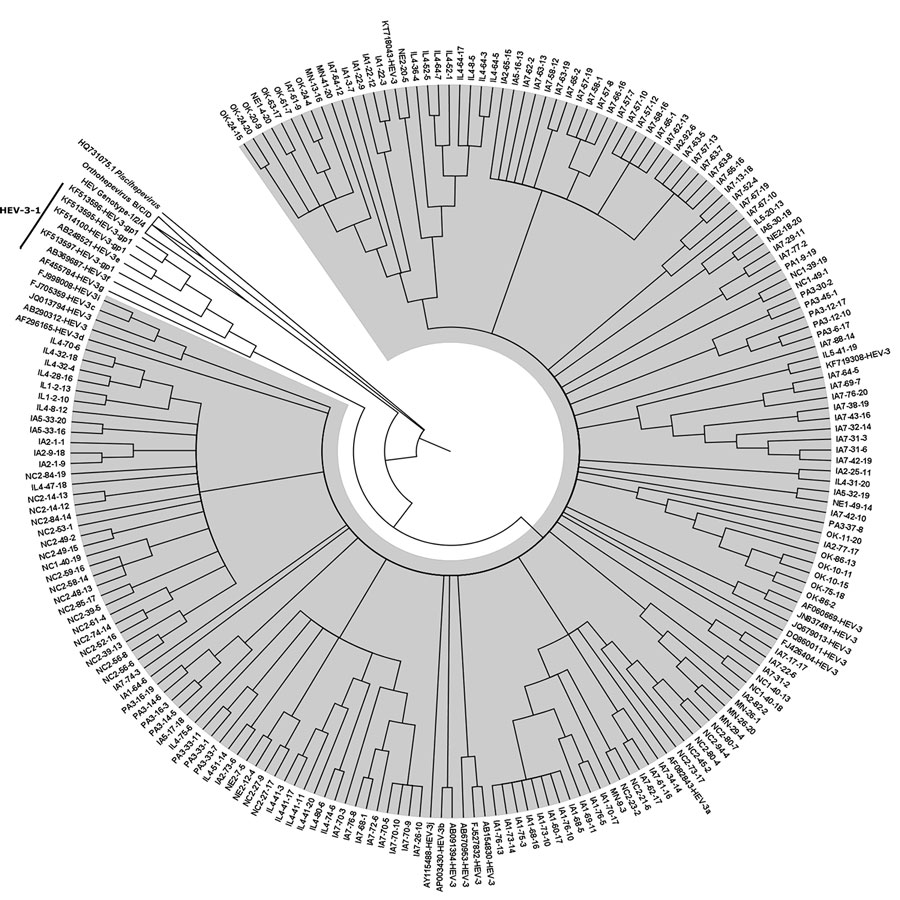Volume 26, Number 2—February 2020
Dispatch
Hepatitis E Virus in Pigs from Slaughterhouses, United States, 2017–2019
Figure

Figure. Phylogenic tree of the capsid gene region of reference HEV-1, HEV-2, HEV-3, and HEV-4 strains within species Orthohepevirus A, representative HEV strains from species Orthohepeviruses B, C, and D, as well as the cutthroat trout virus in the genus Piscihepevirus. The phylogenetic analysis was performed by using MEGA6 software (http://www.megasoftware.net) and the maximum-likelihood bootstrap method based on the Tamura-Nei model (1). The figure represents a cladogram. The HEV-3abchij sequences belonging to HEV-3 group 2 (HEV-3–2) are highlighted in gray (n = 182 sequences from slaughterhouse pigs in this study; n = 19 reference sequences from the GenBank database). The HEV-3efg sequences belonging to HEV-3 group 1 (HEV-3–1) are shown on a white background (n = 7 reference sequences from the GenBank database). Reference HEV sequences from genotypes 1/2/4 clade of Orthohepevirus A, and Orthohepevirus B/C/D clade are also shown as collapsed branches, and the cutthroat trout virus within the genus Piscihepevirus is shown as a separate clade. The HEV-3 reference sequences used in the phylogenetic analysis include HEV-3a AF082843, HEV-3b AP003430, HEV-3c FJ705359, HEV-3d AF296165–7, HEV-3e AB248521, HEV-3f AB369687, HEV-3g AF455784, HEV-3h JQ013794, HEV-3i FJ998008, HEV-3j AY115488, HEV-3 AB290312. We also included the following other HEV-3 sequences in the phylogenetic analysis, which were some of the top candidates from our initial BLAST (https://blast.ncbi.nlm.nih.gov/Blast.cgi) analysis: AB091394-HEV-3, AB154830-HEV-3, AB670953-HEV-3, DQ860011-HEV-3, FJ426404-HEV-3, FJ527832-HEV-3, JN837481-HEV-3, KF719308-HEV-3, KT718043-HEV-3. HEV, hepatitis E virus.
References
- Smith DB, Simmonds P, Izopet J, Oliveira-Filho EF, Ulrich RG, Johne R, et al. Proposed reference sequences for hepatitis E virus subtypes. J Gen Virol. 2016;97:537–42. DOIPubMedGoogle Scholar
- Salines M, Andraud M, Rose N. From the epidemiology of hepatitis E virus (HEV) within the swine reservoir to public health risk mitigation strategies: a comprehensive review. Vet Res (Faisalabad). 2017;48:31. DOIPubMedGoogle Scholar
- Ticehurst JR, Pisanic N, Forman MS, Ordak C, Heaney CD, Ong E, et al. Probable transmission of hepatitis E virus (HEV) via transfusion in the United States. Transfusion. 2019;59:1024–34. DOIPubMedGoogle Scholar
- Roth NJ, Schäfer W, Alexander R, Elliott K, Elliott-Browne W, Knowles J, et al. Low hepatitis E virus RNA prevalence in a large-scale survey of United States source plasma donors. Transfusion. 2017;57:2958–64. DOIPubMedGoogle Scholar
- Huang FF, Haqshenas G, Guenette DK, Halbur PG, Schommer SK, Pierson FW, et al. Detection by reverse transcription-PCR and genetic characterization of field isolates of swine hepatitis E virus from pigs in different geographic regions of the United States. J Clin Microbiol. 2002;40:1326–32. DOIPubMedGoogle Scholar
- Feagins AR, Opriessnig T, Guenette DK, Halbur PG, Meng XJ. Detection and characterization of infectious Hepatitis E virus from commercial pig livers sold in local grocery stores in the USA. J Gen Virol. 2007;88:912–7. DOIPubMedGoogle Scholar
- Jothikumar N, Cromeans TL, Robertson BH, Meng XJ, Hill VR. A broadly reactive one-step real-time RT-PCR assay for rapid and sensitive detection of hepatitis E virus. J Virol Methods. 2006;131:65–71. DOIPubMedGoogle Scholar
- Dong C, Meng J, Dai X, Liang JH, Feagins AR, Meng XJ, et al. Restricted enzooticity of hepatitis E virus genotypes 1 to 4 in the United States. J Clin Microbiol. 2011;49:4164–72. DOIPubMedGoogle Scholar
- Meng XJ, Purcell RH, Halbur PG, Lehman JR, Webb DM, Tsareva TS, et al. A novel virus in swine is closely related to the human hepatitis E virus. Proc Natl Acad Sci U S A. 1997;94:9860–5. DOIPubMedGoogle Scholar
- Grierson S, Heaney J, Cheney T, Morgan D, Wyllie S, Powell L, et al. Prevalence of hepatitis E virus infection in pigs at the time of slaughter, United Kingdom, 2013. Emerg Infect Dis. 2015;21:1396–401. DOIPubMedGoogle Scholar
- Crossan C, Grierson S, Thomson J, Ward A, Nunez-Garcia J, Banks M, et al. Prevalence of hepatitis E virus in slaughter-age pigs in Scotland. Epidemiol Infect. 2015;143:2237–40. DOIPubMedGoogle Scholar
- Tessé S, Lioure B, Fornecker L, Wendling MJ, Stoll-Keller F, Bigaillon C, et al. Circulation of genotype 4 hepatitis E virus in Europe: first autochthonous hepatitis E infection in France. J Clin Virol. 2012;54:197–200. DOIPubMedGoogle Scholar
- Said B, Usdin M, Warburton F, Ijaz S, Tedder RS, Morgan D. Pork products associated with human infection caused by an emerging phylotype of hepatitis E virus in England and Wales. Epidemiol Infect. 2017;145:2417–23. DOIPubMedGoogle Scholar
- Perumpail RB, Ahmed A, Higgins JP, So SK, Cochran JL, Drobeniuc J, et al. Fatal accelerated cirrhosis after imported HEV genotype 4 infection. Emerg Infect Dis. 2015;21:1679–81. DOIPubMedGoogle Scholar
- Feagins AR, Opriessnig T, Guenette DK, Halbur PG, Meng XJ. Inactivation of infectious hepatitis E virus present in commercial pig livers sold in local grocery stores in the United States. Int J Food Microbiol. 2008;123:32–7. DOIPubMedGoogle Scholar
1These first authors contributed equally to this article.